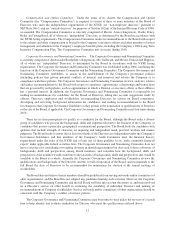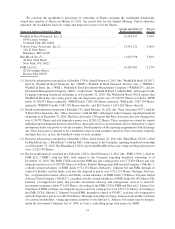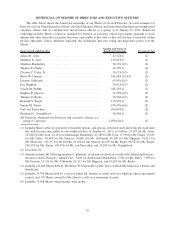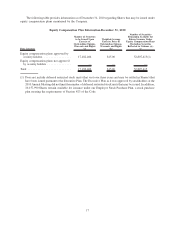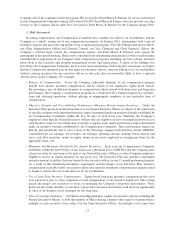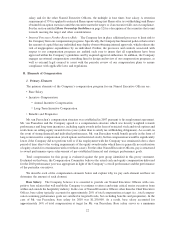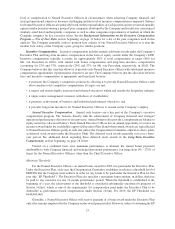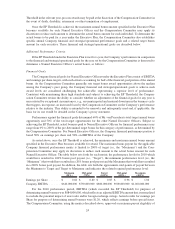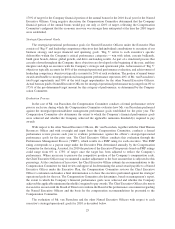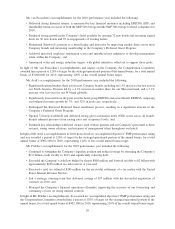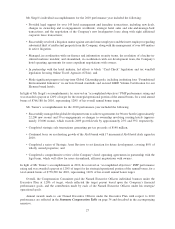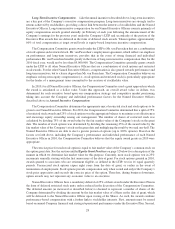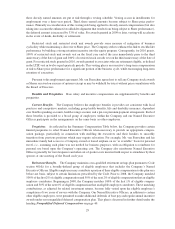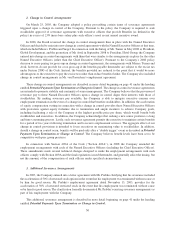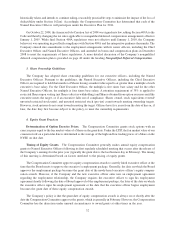Starwood 2010 Annual Report Download - page 34
Download and view the complete annual report
Please find page 34 of the 2010 Starwood annual report below. You can navigate through the pages in the report by either clicking on the pages listed below, or by using the keyword search tool below to find specific information within the annual report.salary and for the other Named Executive Officers, the multiple is four times base salary. A retention
requirement of 35% is applied to restricted Shares upon vesting (net Shares after tax withholding) and Shares
obtained from option exercises until the executive meets the target, or if an executive falls out of compliance.
See the section entitled Share Ownership Guidelines on page 32 for a description of the securities that count
towards meeting the target and other considerations.
•Internal Processes Further Restrict Risk: The Company has in place additional processes to limit risk to
the Company from our compensation programs. Specifically, the Company has financial policies that restrict
the amount of capital that any individual may deploy absent obtaining internal approvals, which reduces the
risk of inappropriate expenditures by an individual. Further, the processes and controls associated with
respect to our compensation programs are audited each year to insure that all expenditures have been
approved within the Company’s guidelines and by required approval authorities. In addition, the Company
engages an external compensation consulting firm for design and review of our compensation programs, as
well as external legal counsel to assist with the periodic review of our compensation plans to ensure
compliance with applicable laws and regulations.
B. Elements of Compensation
1. Primary Elements
The primary elements of the Company’s compensation program for our Named Executive Officers are:
• Base Salary
• Incentive Compensation
OAnnual Incentive Compensation
OLong-Term Incentive Compensation
• Benefits and Perquisites
Mr. van Paasschen’s compensation structure was established in 2007 pursuant to his employment agreement.
Mr. van Paasschen and the Company agreed to a compensation structure which was heavily weighted towards
performance and long-term incentives, including equity awards in the form of restricted stock and stock options and
restrictions on selling equity awards for two years (other than to satisfy tax withholding obligations). As a result, in
the event of strong financial and individual performance, Mr. van Paasschen would benefit greatly in the form of
long-term incentive compensation (stock options and restricted stock), but his compensation would be significantly
lower if the Company did not perform well or if his employment with the Company was terminated after a short
period of time (due to the vesting requirements of the equity awards under which there is generally no acceleration
of equity awards for a termination with or without cause). For the other Named Executive Officers, pay is structured
to award performance upon achievement of pre-established financial and strategic performance goals.
Total compensation for this group is evaluated against the peer group identified in this proxy statement.
Evaluated on this basis, the Compensation Committee believes the actual cash and equity compensation delivered
for the 2010 performance year was appropriate in light of the Company’s overall performance and the performance
of the particular executives.
We describe each of the compensation elements below and explain why we pay each element and how we
determine the amount of each element.
Base Salary. The Company believes it is essential to provide our Named Executive Officers with com-
petitive base salaries that will enable the Company to continue to attract and retain critical senior executives from
within and outside the hospitality industry. In the case of Named Executive Officers other than the Chief Executive
Officer, base salary typically accounts for approximately 20% of total compensation at target (i.e., total compen-
sation assuming performance goals are satisfied at targeted levels, but excluding benefits and perquisites). In the
case of Mr. van Paasschen, base salary for 2010 was $1,250,000. As a result, base salary accounted for
approximately 14% of total compensation at target for Mr. van Paasschen. Base salary serves as a minimum
22


